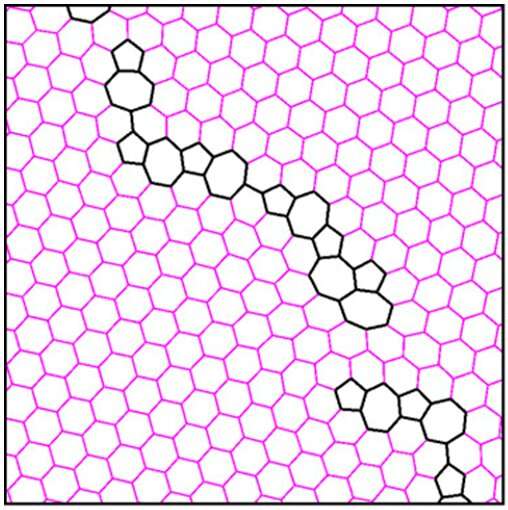Grain boundaries in graphene do not affect spin transport

Researchers from the ICN2 Theoretical and Computational Nanoscience Group as well as the Université catholique de Louvain have used numerical simulations to show that spin diffusion length is independent of grain size. The results are published in Nano Letters and have implications for the optimization of graphene-based spintronic devices.
Graphene is a material that has been gaining fame in recent years due to its magnificent properties. In particular, for spintronics, graphene is a valuable material because the spins of the electrons used remain unaltered for a relatively long time. However, graphene needs to be produced on a large scale in order to be used in future devices. With that respect, chemical vapor deposition (CVD) is the most promising fabrication method.
CVD involves growing graphene on a metallic substrate at high temperatures. In this process, the generation of graphene starts at different points of the substrate simultaneously. This produces different single-crystal domains of graphene separated from one another through grain boundaries, consisting of arrays of five-, seven- or even eight-member carbon rings. The final product is, thus, polycrystalline graphene.
Is polycrystalline graphene as good as single-crystal graphene for spintronics? Grain boundaries are a significant source of charge scattering, increasing the electric resistance of the material. How do they affect spin transport?
Some experiments suggest that grain boundaries do not play a major role on spin transport. In this context, Dr. Aron W. Cummings, from the ICN2 Theoretical and Computational Nanoscience Group, led by ICREA Prof. Stephan Roche, together with researchers from the Université catholique de Louvain (Belgium), have used first-principles simulations to study the impact of grain boundaries on spin transport in polycrystalline graphene. The study is published in Nano Letters.
The researchers have considered two different mechanisms by which spins could lose their original orientation (spin relaxation). One accounts for the randomization of spins within the grains due to spin-orbit coupling, the other considers the possibility of the spins to flip due to scattering in a grain boundary. However, the researchers found that the latter case did not happen. Grain boundaries do not have any adverse effect on spin transport.
Therefore, spin diffusion length in polycrystalline graphene is independent of grain size and depends only on the strength of the substrate-induced spin-orbit coupling. Moreover, this is valid not only for the diffusive regime of transport, but also for the weakly localized one, in which quantum phenomena begin to prevail. This is the first quantum mechanical simulation confirming that the same expression for spin diffusion length holds in both regimes.
The research highlights the fact that single-domain graphene may not be a requirement for spintronics applications, and that polycrystalline CVD-grown graphene may work just as well. This puts the focus on other aspects to enhance in graphene production, such as the elimination of magnetic impurities.
More information: Aron W. Cummings, Simon M.-M. Dubois, Jean-Christophe Charlier, and Stephan Roche. Universal Spin Diffusion Length in Polycrystalline Graphene. Nano Letters 2019 19 (10), 7418-7426. DOI: 10.1021/acs.nanolett.9b03112
Journal information: Nano Letters




















